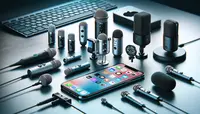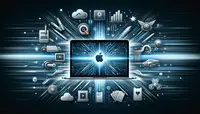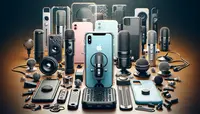The Evolution of iPhone Microphone Technology
Since its inception in 2007, the iPhone has not just been a device for calls and messages; it has grown to become a multifaceted tool for multimedia creation, particularly in audio recording.
This blog post explores the evolution of iPhone microphone technology, tracing its journey from the original iPhone to the present day.
The Beginnings: iPhone (2007)
The original iPhone, released in 2007, marked a significant step in mobile technology. The microphone in this model was basic, primarily intended for voice calls and simple recordings. It captured sound in a mono format, meaning it recorded a single audio channel. This setup was sufficient for phone calls but limited for any advanced audio recording.
iPhone 4: The Introduction of a Secondary Mic (2010)
The iPhone 4 was a game-changer in many respects, including its microphone technology. For the first time, a secondary microphone was introduced for noise cancellation. This dual-mic system helped in filtering out background noise during calls, significantly improving call clarity. However, for recording purposes, the microphone setup was still relatively rudimentary.
iPhone 5: Enhanced Microphone Quality (2012)
With the iPhone 5, Apple took a significant leap in microphone technology. This model featured three microphones – at the bottom, front, and back. This improvement was not just about noise cancellation; it was also about enhancing overall sound quality. The three-mic system allowed for better voice capture and clearer audio for video recordings.
iPhone 6 and 6S: Focus on Video and Voice (2014-2015)
The iPhone 6 and 6S series continued to improve on the multi-microphone approach. Apple began to emphasize the importance of the iPhone in video production, recognizing that good video needs equally good audio. These models saw improvements in audio processing algorithms, leading to crisper and more vibrant sound capture.
iPhone X: Beamforming Technology (2017)
The iPhone X introduced a significant advancement with beamforming technology. This technique uses the multiple microphones to focus on the sound from a specific direction while minimizing background noise. This development was particularly beneficial for video recording and voice commands.
iPhone 12 and Beyond: Studio-Quality Recording (2020)
By the time the iPhone 12 rolled out, Apple was not just competing in the phone market; it was setting standards in portable audio recording. The iPhone 12 series boasted improved hardware and software integration, offering near-studio-quality recording capabilities.
If you can now use the iPhone‘s Microphone for professionnal recordings, you will still have a better quality using an external microphone for your iPhone.
The Future
As we look to the future, the evolution of iPhone microphone technology shows no signs of slowing down. With each new iteration, Apple continues to push the boundaries, integrating more sophisticated hardware with advanced software algorithms. The potential for even more immersive and high-fidelity audio experiences is vast, signaling exciting times ahead for iPhone users and audio enthusiasts alike.










Post your comment